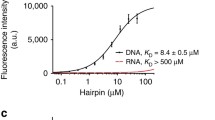Abstract
Dyes that bind to DNA, such as Hoechst 33342, are commonly used to visualize chromatin in live cells by fluorescence microscopy. A caveat is that the probes themselves should not perturb cellular responses and under normal conditions the dyes are generally non-toxic. However, researchers are increasingly using computerized time-lapse microscopy (CTLM), where cells stained with fluorescent dyes are often imaged frequently over a period of several days, to follow cellular responses in real time. Little is currently known about possible toxicity of fluorescent DNA dyes under CTLM conditions. In this study we demonstrate that the common live-cell DNA stain Hoechst 33342 can cause apoptosis under CTLM conditions. Although toxicity is evident at long times in the absence of imaging at high dye concentrations, phototoxicity from repeated excitation of the dye in the imaging process is dominant. We show that phototoxicity is a function of the product of light fluence and dye concentration, irrespective of irradiance, frequency and total number of scans. Thus, phototoxicity can be prevented by a combination of dye concentration and imaging procedure that is below this threshold. These quantitative data can be used as a guide to others performing time-lapse microscopy studies with this common live-cell DNA stain and serves as a caution for researchers when using other fluorescent stains under CTLM conditions.
Similar content being viewed by others
References
K. T. Chan, C. L. Cortesio, A. Huttenlocher, Integrins in cell migration, Methods Enzymol., 2007, 426, 47–67.
K. Chu, N. Teele, M. W. Dewey, N. Albright, W. C. Dewey, Computerized video time lapse study of cell cycle delay and arrest, mitotic catastrophe, apoptosis and clonogenic survival in irradiated 14-3-3 sigma and CDKN1A (p21) knockout cell lines, Radiat. Res., 2004, 162, 270–286.
E. Meijering, O. Dzyubachyk, I. Smal, W. A. van Cappellen, Tracking in cell and developmental biology, Semin. Cell Dev. Biol., 2009, 20, 894–902.
D. Mullassery, C. A. Horton, C. D. Wood, M. R. White, Single live-cell imaging for systems biology, Essays Biochem., 2008, 45, 121–133.
N. Rubio, A. Rajadurai, K. D. Held, K. M. Prise, H. L. Liber, R. W. Redmond, Real-time imaging of novel spatial and temporal responses to photodynamic stress, Free Radical Biol. Med., 2009, 47, 283–290.
Z. Darzynkiewicz, E. Bedner, Analysis of apoptotic cells by flow and laser scanning cytometry, Methods Enzymol., 2000, 322, 18–39.
M. Colly-d’Hooghe, A. J. Valleron, E. P. Malaise, Time-lapse cinematography studies of cell cycle and mitosis duration, Exp. Cell Res., 1977, 106, 405–407.
R. R. Heye, E. W. Kiebler, R. J. Arnzen, L. J. Tolmach, Mulitiplexed time-lapse photomicrography of cultured cells, J. Microsc., 1982, 125, 41–50.
D. Sylwester, S. M. Dennis, M. Absher, Computer processing of cell lineage data from time-lapse cinematography studies, Comput. Biol. Med., 1980, 10, 103–108.
L. H. Thompson, H. D. Suit, Proliferation kinetics of X-irradiated mouse L cells studied wih time lapse photography. II, Int. J. Radiat. Biol., 1969, 15, 347–362.
A. P. Tolmach, A. R. Mitz, S. L. Von Rump, M. L. Pepper, L. J. Tolmach, Computer-assisted analysis of time-lapse cinemicrographs of cultured cells, Comput. Biomed. Res., 1978, 11, 363–379.
B. Endlich, I. R. Radford, H. B. Forrester, W. C. Dewey, Computerized video time-lapse microscopy studies of ionizing radiation-induced rapid-interphase and mitosis-related apoptosis in lymphoid cells, Radiat. Res., 2000, 153, 36–48.
H. B. Forrester, N. Albright, C. C. Ling, W. C. Dewey, Computerized video time-lapse analysis of apoptosis of REC:Myc cells X-irradiated in different phases of the cell cycle, Radiat. Res., 2000, 154, 625–639.
H. B. Forrester, C. A. Vidair, N. Albright, C. C. Ling, W. C. Dewey, Using computerized video time lapse for quantifying cell death of X-irradiated rat embryo cells transfected with c-myc or c-Ha-ras, Cancer Res., 1999, 59, 931–939.
M. Guo, C. H. Chen, C. A. Vidair, S. Marino, W. C. Dewey, C. C. Ling, Characterizarion of radiation-induced apoptosis in rodent cell lines, Radiat. Res., 1997, 147, 295–303.
C. A. Vidair, C. H. Chen, C. C. Ling, W. C. Dewey, Apoptosis induced by X-irradiation of rec-myc cells is postmitotic and not predicted by the time after irradiation or behavior of sister cells, Cancer Res., 1996, 56, 4116–4118.
R. E. Durand, P. L. Olive, Cytotoxicity, mutagenicity and DNA damage by Hoechst 33342, J. Histochem. Cytochem., 1982, 30, 111–116.
X. Zhang, B. Chen, B. Davis, F. Kiechle, Hoechst 33342 induces apopotosis in HL-60 cells and inhibits topisomerase I in vivo, Arch. Pathol. Lab. Med., 1999, 123, 921–927.
Author information
Authors and Affiliations
Corresponding author
Rights and permissions
About this article
Cite this article
Purschke, M., Rubio, N., Held, K.D. et al. Phototoxicity of Hoechst 33342 in time-lapse fluorescence microscopy. Photochem Photobiol Sci 9, 1634–1639 (2010). https://doi.org/10.1039/c0pp00234h
Received:
Accepted:
Published:
Issue Date:
DOI: https://doi.org/10.1039/c0pp00234h




